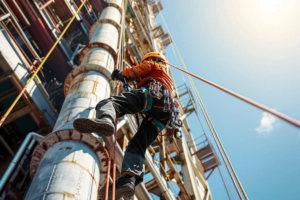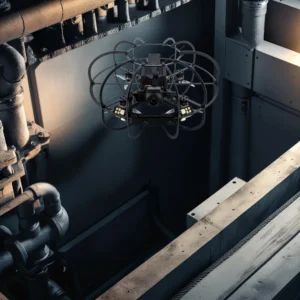A strategic choice for your inspections
Faced with increasingly complex inspection requirements, companies are often faced with a dilemma: whether to opt for the human expertise of a rope access technician or the technological precision of a drone. Each method has its own advantages and limitations, and the choice depends on a number of criteria, such as the type of intervention, budget or environmental constraints. This article compares these two approaches to help you choose the one that best suits your project.
Rope access technicians: human expertise at the service of inspection
Definition of a rope access technician
A rope access technician is a professional specialized in working at heights, equipped with mountaineering equipment to access difficult-to-reach areas. Versatile, rope access technicians carry out visual inspections, technical surveys and maintenance work in a variety of environments, including building facades, wind turbines and industrial facilities.
Advantages of rope access
Adaptability: Thanks to their expertise and ability to operate in complex environments, rope access technicians can operate in areas where machines are limited, such as congested spaces or places where a human presence is essential to assess certain problems.
Versatility: In addition to inspections, rope access technicians can carry out immediate repairs or other tasks requiring manual skills.
Human precision: Unlike drones, rope access technicians can touch and handle the structures being inspected, enabling them to detect defects invisible to the naked eye or cameras.
Rope access limits
Safety: Working at height poses significant risks for rope access technicians, even when they are properly trained and equipped. Accidents, though rare, can be serious.
High cost : The mobilization of rope access technicians involves costs related to their expertise, their equipment, and the necessary safety measures.
Response time: Installing rope access equipment and securing the site can be time-consuming, lengthening mission times.
Drones: innovative technology for safe inspection
Definition of an inspection drone
An inspection drone is a remote-controlled or semi-autonomous device, equipped with high-resolution cameras and sensors (thermal, infrared, etc.), designed to collect visual or technical data in difficult-to-access environments. Used mainly in industry, construction or energy, these drones offer a fast, safe solution for complex inspections.
Advantages of drones
Optimum safety: Drones eliminate the need to send workers into hazardous environments, reducing the risk of accidents.
Speed and efficiency: Once on site, a drone can be up and running in a matter of minutes, covering a large area in a short space of time.
Cost savings: the costs of using drones (operators, maintenance) are generally lower than those of a team of rope access technicians.
Access to complex areas: Drones can reach places inaccessible to humans or requiring costly logistics, such as very high structures or narrow ducts.
Advanced data collection: with their high-performance sensors, drones provide precise images, 3D surveys or thermal analyses, enabling detailed and comprehensive inspections.
Drone limitations
Technical limitations: Drones cannot carry out repairs or direct interventions on structures. Their role is limited to data collection.
Dependence on environmental conditions: Wind, rain or electromagnetic interference can affect drone performance.
Initial investment: Purchasing or leasing professional drones, as well as training operators, can represent a substantial investment.
Detailed comparison: rope access VS drone
Technical criteria
Flexibility: Rope access technicians can adapt to a wide variety of situations, especially those requiring manual intervention. Drones, though innovative, are limited to visual or technical inspections.
Accuracy: Drones outperform rope access technicians when it comes to capturing detailed images and providing digital data, but rope access technicians remain unbeatable when it comes to identifying certain tactile or structural defects.
Financial aspects
Initial cost: The cost of a drone, including maintenance and operator, is generally lower than that of a team of rope access technicians.
Time and efficiency: drones can complete a mission in a few hours, compared with a day or more for rope access technicians, reducing the cost of intervention time.
Safety and regulations
Safety: drones offer a much safer alternative, eliminating the risks associated with working at height.
Regulations: rope access technicians are subject to safety regulations for working at height, while drones must comply with outdoor aerial regulations. However, indoor drones are not subject to these restrictions, giving them an advantage in indoor inspections.
Which method is best suited to your project?
The choice between a rope access technician and a drone depends above all on the nature of your project. If your objective is a fast, safe and cost-effective inspection, a drone is generally the best option. On the other hand, for complex operations requiring human expertise or immediate action, rope access technicians are still a must.
In many cases, the ideal approach is to combine both solutions: drones for rapid initial analysis, and rope access technicians for targeted interventions. By understanding the strengths and limitations of each method, you can optimize your inspections while ensuring safety and efficiency.




